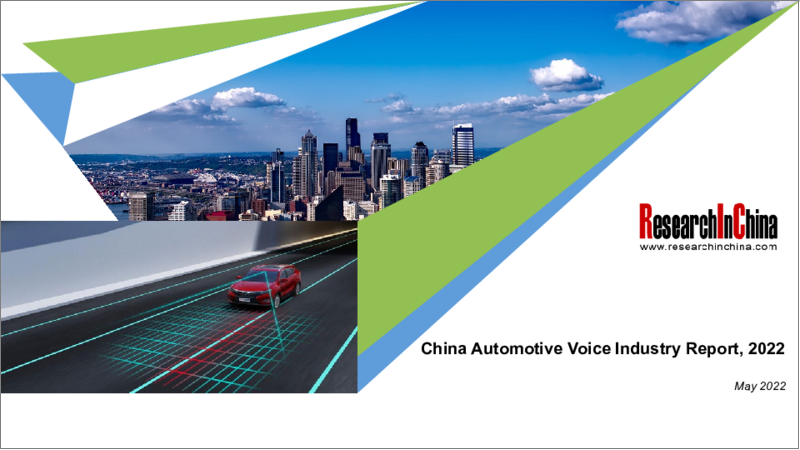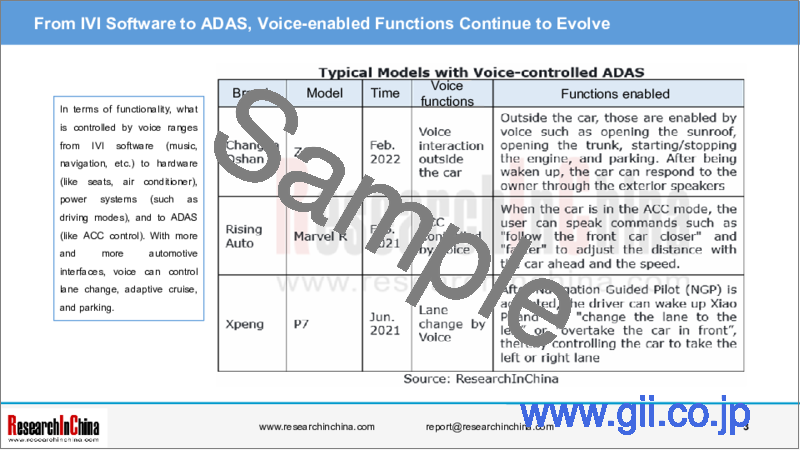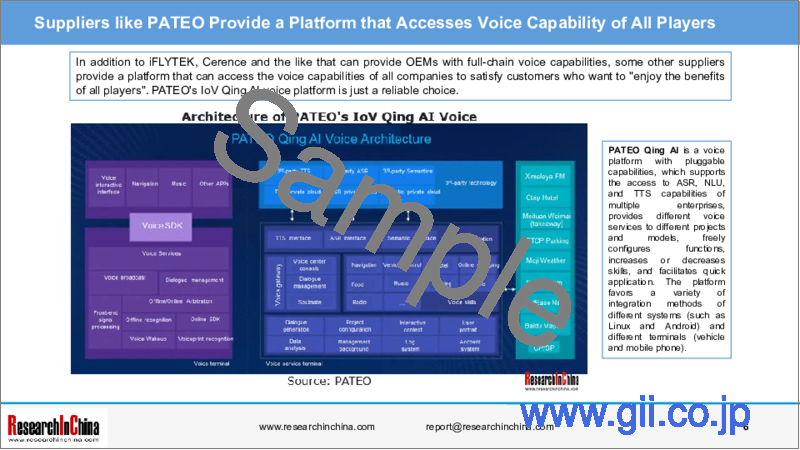|
|
市場調査レポート
商品コード
1073241
中国の自動車音声認識産業:2021-2022年China Automotive Voice Industry Report, 2021-2022 |
||||||
| 中国の自動車音声認識産業:2021-2022年 |
|
出版日: 2022年05月06日
発行: ResearchInChina
ページ情報: 英文 170 Pages
納期: 即日から翌営業日
|
- 全表示
- 概要
- 目次
2021年、中国では1,300万台以上の乗用車が音声認識機能を搭載し、前年比13%増、搭載率は68%に達しました。iFLYTEKとCerenceが2大リーダー企業であり、合わせて70%以上のシェアを占めています。
当レポートでは、中国の自動車音声認識の市場を調査し、インテリジェント音声認識の概要、技術動向、市場規模、市場シェア、自動車音声認識の概要、機能の比較、中国における自動車音声認識製品の導入動向、技術・製品プロバイダー、開発動向などをまとめています。
目次
第1章 インテリジェント音声認識産業
- インテリジェント音声認識の定義
- インテリジェント音声認識の開発履歴
- インテリジェント音声認識技術の開発
- インテリジェント音声認識のアプリケーションシナリオ
- インテリジェント音声認識の産業チェーン
- インテリジェント音声認識市場の規模
- 中国のインテリジェント音声認識市場
- 中国のインテリジェント音声認識市場のシェア
第2章 自動車音声認識産業
- 自動車音声認識のインタラクティブプロセス
- 自動車音声認識のインタラクティブ機能
- 自動車音声認識の開発履歴
- 中国における自動車インテリジェント音声認識企業の分類
- 中国の自動車音声認識サプライヤーのソリューション
- 中国の自動車音声認識サプライヤーのコアテクノロジーの比較
- サプライヤーのオープンプラットフォームの比較
- 中国の乗用車ブランドの自動車音声認識機能の比較
- 主要車両モデルの音声認識機能
- 自動車音声認識:成長要因
- 自動車音声認識:インターネット企業の比較
第3章 中国における自動車音声認識製品の導入動向 (データ分析)
- 中国の乗用車への音声認識機能の導入数/導入率:概要
- 中国の乗用車への音声認識機能の導入数/導入率:ブランド別
- JVブランド乗用車への音声認識機能の導入数/導入率:概要
- JVブランド乗用車への音声認識機能の導入数/導入率:価格別
- 中国ブランド乗用車への音声認識機能の導入数/導入率:概要
- 音声認識機能のアセンブリー数・中国ブランド乗用車への導入:価格別
- 中国の乗用車音声認識市場の競合情勢
第4章 自動車音声認識プロバイダー
- iFLYTEK
- Cerence
- AIspeech
- Unisound
- txzing.com
- VW-Mobvoi
- Pachira
- PATEO
- Tencent
- Baidu
- Alibaba
第5章 自動車音声認識の開発動向
Automotive voice market: The boom of self-research by OEMs will promote reform in the supply mode
Before the advent of fully automated driving, the user focus on driving, and voice interaction is still the most convenient and safest interaction mode in vehicles.
In 2021, over 13 million passenger cars in China carried voice feature, with a year-on-year increase of 13% and an installation rate of 68%. The market bore a rapid bullish trend.
In 2021, more than 5.5 million vehicles of Chinese automakers were outfitted with voice feature, a year-on-year spike of 40.4%. Among the top four brands, BYD saw the voice installations soar by 151% on an annualized basis, and Haval's rose 53% from a year earlier.
From IVI software to ADAS, voice-enabled functions continue to evolve
In terms of functionality, what is controlled by voice ranges from IVI software (music, navigation, etc.) to hardware (like seats, air conditioner), power systems (such as driving modes), and to ADAS (like ACC control). With more and more automotive interfaces, voice can control lane change, adaptive cruise, and parking.
iFLYTEK and Cerence are the top two leaders
Among suppliers, iFLYTEK and Cerence are in the first echelon, together sweeping more than 70% market shares.
iFLYTEK shipped more than 7 million sets of voice products in 2021, a figure projected to outnumber 9 million sets in 2022 still as the largest supplier in the market.
iFLYTEK mainly serves Chinese carmakers, and the average unit price of models supported ranges from RMB150,000 to RMB200,000. In the OEM market, iFlytek's voice products have been available in excess of 36 million vehicles, being merited as follows:
- iFLYTEK has delved in the automotive field for 19 years as the industry's leader in multilingual automatic speech recognition (ASR), text-to-speech (TTS) and other technologies;
- The Feiyu (flying fish) system for automakers employs a software and hardware platform design, which can be reused by multiple models and be introduced rapidly to vehicle models with varying market targets, prices and configurations.
With superiorities in AI expertise, data accumulation as well as the software and hardware platforms that can offer custom-made services, iFLYTEK has become a heavyweight in the automotive voice industry. But other rivals should not be underestimated, especially Cerence (separated from Nuance, a world-renowned giant in intelligent voice).
In 2020, Geely's China Euro Vehicle Technology (CEVT) and Great Wall Motor's strategic partner Bean Tech announced to select Cerence ARK to develop automotive voice assistants. NIO also proclaimed to introduce Cerence's voice technology. Prior to this, these brands were all customers of iFLYTEK.
Cerence ARK is an end-to-end AI-powered automotive assistant solution that integrates interactive voice AI technologies such as environment-adaptive voice signal enhancement, custom wake-up words, random interruption of dialogue, multi-intent semantic understanding, wake-up-free multi-round dialogue, and cross-domain dialogue in support of context understanding. Cerence ARK is a turnkey automotive product that enables automakers to quickly develop, deploy and manage a fully localized automotive voice assistant.
In addition, Cerence supports more than 70 languages around the world, making it the best choice for Chinese brands to go overseas. Automakers such as SAIC, Geely, Wuling Motors, NIO and Hongqi have all used Cerence's voice technology in their overseas models.
In addition to iFLYTEK, Cerence and the like that can provide OEMs with full-chain voice capabilities, some other suppliers provide a platform that can access the voice capabilities of all companies to satisfy customers who want to "enjoy the benefits of all players". PATEO's IoV Qing AI voice platform is just a reliable choice.
PATEO Qing AI is a voice platform with pluggable capabilities, which supports the access to ASR, NLU, and TTS capabilities of multiple enterprises, provides different voice services to different projects and models, freely configures functions, increases or decreases skills, and facilitates quick application. The platform favors a variety of integration methods of different systems (such as Linux and Android) and different terminals (vehicle and mobile phone).
At present, PATEO's Qing AI voice platform has been connected to the voice capabilities of Cerence, Baidu, AIspeech and iFlytek. It enables full-duplex voice interaction, multi-round dialogue, deep contextual memory and understanding, wake-up-free, "what you see is what you can say", voice source positioning, voiceprint recognition, voice cloning and other functions. It has been seen in FAW VW, Dongfeng Motor, Wuling Motors (Silver Badge), BEIJING Auto, Geely, etc. The PATEO voice product carried by Voyah FREE supports four-tone-zone voice recognition, multi-round dialogue, navigation, music, car control, and "what you see is what you can say about setting interfaces", greetings and other functions.
No matter how much suppliers offer, it cannot compete with the lucrativeness brought by "mastery of the core data"
Although the solution packages of suppliers are fine, OEMs want more in terms of function differentiation, security guarantee of open automotive interfaces, quick response of OTA and user data. The OEMs represented by Xpeng and Li Auto have adopted the development model of "introducing the underlying technology of suppliers and developing their own voice system".
Like Xpeng and Li Auto vigorously developing voice on their own, Volkswagen, Geely, Great Wall Motor, etc. are sparing no efforts in self-developed voice by setting up subsidiaries.
In a nutshell, the mode of traditional OEMs applying suppliers' solution packages has quietly transferred to the in-depth cooperation between OEMs (with more detailed needs) and technology providers (responsible for delivery). OEMs are not only demanders, but also technology suppliers and system integrators in the voice supply chain. For traditional voice suppliers, the "reform" has kicked off.
Table of Contents
1 Intelligent Voice Industry
- 1.1 Definition of Intelligent Voice
- 1.2 Development History of Intelligent Voice
- 1.3 Development of Intelligent Voice Technology
- 1.4 Application Scenarios of Intelligent Voice
- 1.5 Intelligent Voice Industry Chain
- 1.6 Intelligent Voice Market Size
- 1.7 Intelligent Voice Market in China
- 1.8 Intelligent Voice Market Share in China
2 Automotive Voice Industry
- 2.1 Interactive Process of Automotive Voice
- 2.2 Interactive Functions of Automotive Voice
- 2.3 Development History of Automotive Voice
- 2.4 Classification of Automotive Intelligent Voice Enterprises in China
- 2.5 Solutions of Chinese Automotive Voice Suppliers
- 2.6 Comparison of Core Technologies of Chinese Automotive Voice Suppliers
- 2.7 Comparison of Open Platforms of Suppliers
- 2.8 Comparison of Automotive Voice Functions of Chinese Passenger Car Brands (1)
- 2.9 Comparison of Automotive Voice Functions of Chinese Passenger Car Brands (2)
- 2.10 Voice Functions of Benchmark Vehicle Models
- 2.11 Drivers for Automotive Voice
- 2.12 Comparison of Automotive Voice Internet Firms
3 Installation of China's Automotive Voice Products (Data Analysis)
- 3.1 Voice Function Installations/Installation Rate of Passenger Cars in China - Overview
- 3.2 Voice Function Installations/Installation Rate of Passenger Cars in China - by Brands
- 3.3 Voice Function Installations/Installation Rate of Passenger Cars of JV Brands - Overview
- 3.4 Voice Function Installations/Installation Rate of Passenger Cars of JV Brands - by Prices
- 3.5 Voice Function Installations/Installation Rate of Passenger Cars of Chinese Brands - Overview
- 3.6 Voice Function Assembly Volume and Rate of Passenger Cars of Chinese Brands - by Prices
- 3.7 Competitive Landscape of Chinese Passenger Car Voice Market
4 Automotive Voice Providers
- 4.1 iFLYTEK
- 4.1.1 Profile
- 4.1.2 Intelligent Automotive Product Layout
- 4.1.3 Core Intelligent Vehicle Technology
- 4.1.4 Performance of Intelligent Vehicle Business
- 4.1.5 Automotive Interaction Development Planning
- 4.1.6 Intelligent Voice Cloud Operating System: iFLY OS
- 4.1.7 iFLYTEK Open Platform
- 4.1.8 Automotive Voice Service
- 4.1.9 Intelligent Vehicle Development Strategy
- 4.1.10 Dynamics
- 4.2 Cerence
- 4.2.1 Profile
- 4.2.2 Customers
- 4.2.3 Key Data in 2021
- 4.2.4 Automotive Voice Recognition Hardware Framework
- 4.2.5 ARK
- 4.2.6 Brands Supported by ARK in China
- 4.2.7 SSE
- 4.2.8 Drive
- 4.2.9 Look
- 4.2.10 Product Roadmap
- 4.2.11 Business in China
- 4.2.12 Cases
- 4.2.13 Dynamics
- 4.3 AIspeech
- 4.3.1 Profile
- 4.3.2 Core Technology
- 4.3.3 IoV Solution 3.0
- 4.3.4 Lyra Automotive Voice Assistant
- 4.3.5 Microphone Array
- 4.3.6 DUI Voice Open Platform
- 4.3.7 Cooperative Models
- 4.3.8 AI Chips
- 4.4 Unisound
- 4.4.1 Profile
- 4.4.2 Revenue
- 4.4.3 Voice Open Platform
- 4.4.4 Core Technology
- 4.4.5 Voice Interaction Products
- 4.4.6 Automotive Voice Service
- 4.4.7 AI Voice Chips
- 4.4.8 Voice Cooperation
- 4.5 txzing.com
- 4.5.1 Profile
- 4.5.2 Technical Advantages
- 4.5.3 Cooperation Cases - Aftermarket
- 4.5.4 Voice Recognition Architecture
- 4.6 VW-Mobvoi
- 4.6.1 Profile
- 4.6.2 Main Products
- 4.6.3 Core Technology
- 4.6.4 Full-Stack Automotive Voice Solution
- 4.6.5 Virtual Voice Assistant
- 4.6.6 Voice Solutions
- 4.6.7 Voice Cases
- 4.6.8 OEM Intelligent Connectivity Solution
- 4.6.9 Dynamics
- 4.7 Pachira
- 4.7.1 Profile
- 4.7.2 AI Platform
- 4.7.3 Core Technology
- 4.7.4 Main Products
- 4.7.5 Architecture of Intelligent Automotive Voice Products
- 4.7.6 Advantages of Automotive Voice Service Solution
- 4.7.7 Cooperation with NavInfo
- 4.8 PATEO
- 4.8.1 Profile
- 4.8.2 IoV Qing AI
- 4.8.3 IoV Qing AI Voice
- 4.8.4 Qing Cloud Voice AI Private Cloud Platform
- 4.9 Tencent
- 4.9.1 Profile
- 4.9.2 Development History of Automotive Voice Service
- 4.9.3 AI Lab
- 4.9.4 Intelligent Voice Interaction System of AI Lab
- 4.9.5 Multimodal Interaction of AI Lab
- 4.9.6 Core Technology
- 4.9.7 Voice-in-Car Solution
- 4.9.8 Automotive Voice Front-End Solution
- 4.9.9 Voice Wakeup
- 4.9.10 AI Lab Voice Tool Platform
- 4.9.11 Xiaowei
- 4.9.12 TAI
- 4.9.13 Dynamics
- 4.10 Baidu
- 4.10.1 Profile
- 4.10.2 Core Voice Technology
- 4.10.3 Honghu AI Voice Chip
- 4.10.4 DuerOS for Apollo
- 4.10.5 DuerOS (i)
- 4.10.6 DuerOS (ii)
- 4.10.7 Acquisition of KITT.AI
- 4.10.8 Voice Application
- 4.10.9 Partners
- 4.10.10 Dynamics
- 4.11 Alibaba
- 4.11.1 Profile
- 4.11.2 Core Voice Technology
- 4.11.3 Voice Open Platform
- 4.11.4 NUI Vehicle-Cloud Integrated Platform Architecture
- 4.11.5 Alibaba DAMO Academy's Vehicle-Cloud Integrated Voice Technology Capabilities for Intelligent Hardware
- 4.11.6 Alibaba DAMO Academy's Unified Far-field Front-end Processing Framework Based on Blind Source Separation
- 4.11.7 Front-end Signal Processing Technology Solution
- 4.11.8 Voice Wakeup, Voice Synthesis
- 4.11.9 Voiceprint Technology
- 4.11.10 Alibaba DAMO Academy's AIoT-oriented Voice Interaction Vehicle-Cloud Integrated Engine (NUI-Things)
- 4.11.11 Ouroboros Voice Chip of Alibaba DAMO Academy
- 4.11.12 Automotive Voice Service
- 4.11.13 AliOS-based Banma Smart Mobility System
- 4.11.14 Iteration of Banma Smart Mobility System
- 4.11.15 Derivative Applications of Banma Smart Mobility System
- 4.11.16 Tmall Genie
- 4.11.17 Application of Tmall Genie
- 4.11.18 Dynamics




